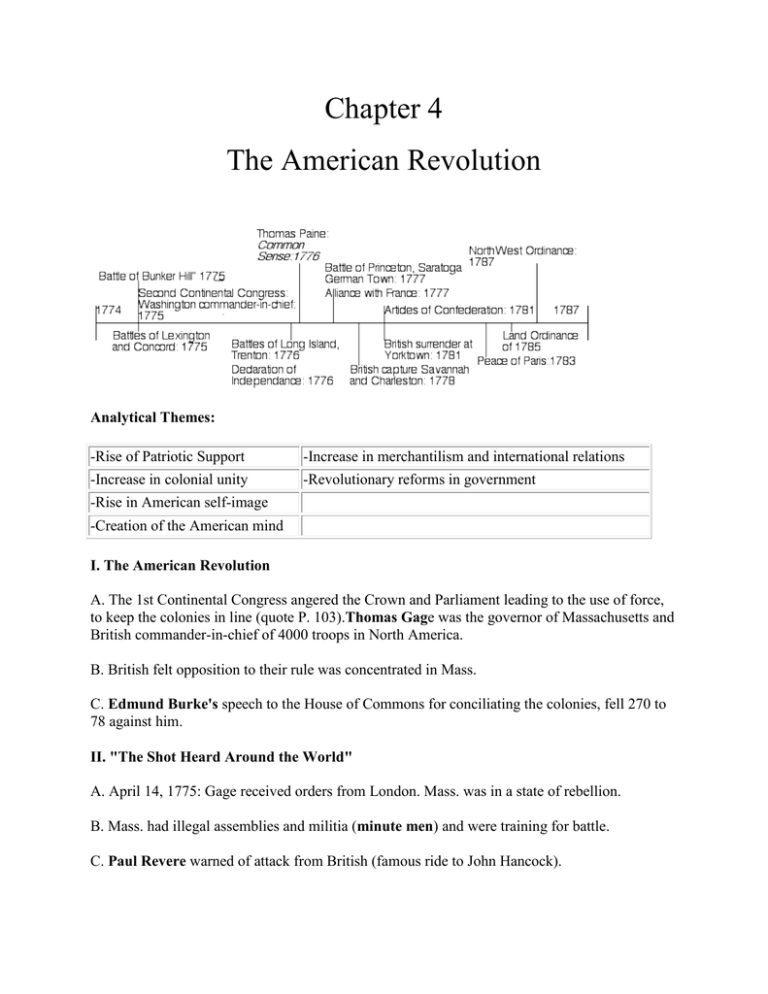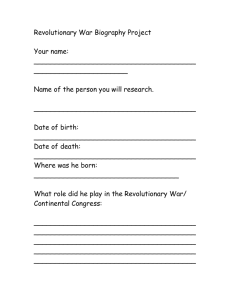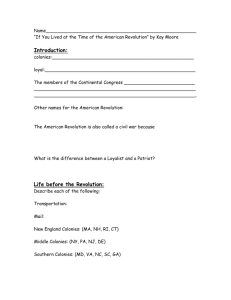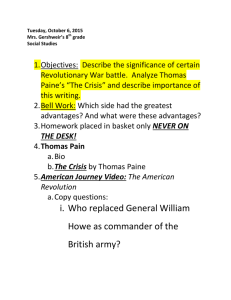Chapter 4
advertisement

Chapter 4 The American Revolution Analytical Themes: -Rise of Patriotic Support -Increase in merchantilism and international relations -Increase in colonial unity -Revolutionary reforms in government -Rise in American self-image -Creation of the American mind I. The American Revolution A. The 1st Continental Congress angered the Crown and Parliament leading to the use of force, to keep the colonies in line (quote P. 103).Thomas Gage was the governor of Massachusetts and British commander-in-chief of 4000 troops in North America. B. British felt opposition to their rule was concentrated in Mass. C. Edmund Burke's speech to the House of Commons for conciliating the colonies, fell 270 to 78 against him. II. "The Shot Heard Around the World" A. April 14, 1775: Gage received orders from London. Mass. was in a state of rebellion. B. Mass. had illegal assemblies and militia (minute men) and were training for battle. C. Paul Revere warned of attack from British (famous ride to John Hancock). D. April 18 1775: Gage sent 700 crack troops to Concord 20 miles away. E. At Lexington en route to Concord, the Redcoats met 70 Minute Men who withdrew after an argument. Shots were fired, 8 patriots died. F. Redcoats entered Concord and destroyed remaining supplies but faced a gauntlet of attack all the way back to Boston. G. Casualties: less than100 Patriots, 273 Redcoats -British were lucky! H. Mass. against the British Empire-wow! I. Mass. takes offensive against some British held forts.-(example Ticonderoga). J. Colonies rallied quickly III. The Second Continental Congress--Philadelphia A. Distinguished group of Radicals-John Adams, Patrick Henry, Samuel Adams, Richard Henry Lee, Gadsden of S.C., Jefferson and Washington, among others. B. Major goal was to unify- John Hancock pleaded for raising and financing an army. C. Washington Commander-in-Chief of new Continental Army. IV. The Battle of Bunker Hill A. Fought on Breed's Hill, not Bunker Hill. B. Colonist take the high ground and Gage attacked -suffering huge losses but the Patriots ran out of ammunition - failure of logistics. C. Fighting poured to the Charleston area of Boston, and casualties were high of British officers. D. Due to the heavy losses, a settlement was likely out of reach. E. Olive Branch Petition -rejected, no reply from Britain-only increased Redcoats. V. The Great Declaration A. Difficult to break from the numerous traditions of England-quote p.106. B. To declare independence would be consiered treason and could result in capital punishment. C. Early protesters to British tyranny were the wealthy, with some middle class citizens participating in mob scenes and meetings. D. Would the Revolution elevate the status of the common man??? Yes, but to what degree and when? E. Patriots felt George III had been mislead by advisers; word of hiring Hessian mercenaries to fight the Patriots angred he colonies and rose fear. F. Publication of Common Sense by Thomas Paine-In simple logic, Paine assaulted the "Royal Brute" George III and the idea of monarchy itself. 1. 150,000 copies sold. 2. Read widely among colonists, but not everone was impressed. 3. "A government of our own is our natural right". 4. John Adams felt Common Sense was somewhat plagiarized. G. Tone of the debate increased-ports were opened to Foreign shipping, privateering was encouraged. H. 1775 Richard Henry Lee introduced a resolution of the the Virgina Convention. P.106. I. At the age of 33, Thomas Jefferson was the youngest member to be placed on the committee, to join John Adams, Ben Franklin, Roger Sherman and Robert Livingston. J. Jefferson returned late in mid-May and was delegated to draft a document-with a few amendments, the draft became the Declaration of Independence-July 4, 1776. K. Declaration had 2 parts: 1. Justifying the theory of republican government. 2. "Injuries and usurpations" by George III 3. Blamed the king rather then Parliment because the king was the personification of the nation the colonies were rebelling against. L. The Declaration of Independence had little immediate impact. M. Some idealist soldiers joined the ranks of the Patriots. N. Later this document (French Revolution) becomes a brilliant cornerstone in most revolutions. O. Why Jefferson? He expressed clearly the views of many liberal patriots in the period-his articulation was a timely and articulate synthesis of the AMERICAN MIND. VI. 1776:The Balance of Forces A. The Declaration did not solve the problem of a new nation at war. B. Loyalists were an obstacle; but the Americans had the home court advantage and popular support-Interesting parallels to Vietnam. C. The British soon learned that logistics, popular support and long supply lines would be costly and protract the war. 1. Also European threats had to be considered. 2. The colonist were mainly English. 3. Cost of men and £s (lbs). D. 1775: attacks in Quebec, Canada met defeat-but the British could not pursue or hold territory beyond forts and urban areas. E. Howe goes to New York to split the colonies and cut communication and supply. F. The British were well prepared and had teh advantage of wealth, size, and experience. Washington had the challenge of organizing a militia force. VII. Loyalists A. Loyalists, or Tories, were present in the colonies. B. 1/5 loyalist- 2/5 Patriots- 2/5 undecided. C. Tory strength was in the rural section of New York and in the North Carolina backcountrychurch leaders, British appointed officials, some merchants and some non-English settlers who relied on the crown for protection from the masses. D. Tories lacked organization. E. Tories felt that the Crown's actions did not merit a revolution that the colonies were destined to lose. F. Great fracturing of families and community, Tory and Patriot battles were gruesome (quote P. 111). VIII. Early Defeats A. Howe left Boston and attacked Washington at New York, The British regular forces were devastating and could have won the war if Howe would have pursued with his navy. B. Howe was not sure if he was a conqueror or peacemaker-the fact that the Colonist were British may have played upon Howe's biases. He held back on a killing blow. C. Washington, frustrated by lack of discipline, reluctantly went to New Jersey to avoid navel superiority. D. Washington and the Continental Army were ravaged in the battles around New York. Washington learned not to put his troops in a vulnerable position by keeping away from the British navy. E. Howe went to winter quarters in New York but posted garrisons in Princeton and Trenton. F. Morale down-Washington makes two bold assaults - Trenton - surprise attack at Christmas Eve captures 900 Hessian soldiers. G. Next he attacked Princeton and out maneuvered William Cornwallis. H. Morale soared and so did the Continental Army's chances-new enlistments. IX. Saratoga and the French Alliance A. British had a three phase plan to route the Continental Army-General Howe's questionable actions and decisions gave the Patriots cause and opportunity!!! 1. General Thomas Burgoyne attacks from Canada to Lake Champlain. 2. British were to attack from Ft. Oswego on Lake Ontario to Albany. 3. Howe attacks up the Hudson to smash the Continental Army - P. 112. B. The goal was to pound the New England states with the logistical advantage of Canada. C. The result is a series of British fiascoes: 1. General Burgoyne attacks from Canada to Lake Champlain; worked taking Ft. TiconderogaBut no support came -Patriots will harass his slow progress and set a trap at Saratoga. 2. Lt. Col. Barry left late and attacked Ft. Oswego allowing Benedict Arnold time to move 1,000 men from Saratoga-Crushed Barry's forces. 3. Howe was wasting time attempting to pin Washington's forces-Washington sent troops to assist Horatio Gates -Howe sent Gen Clinton to support General Burgoyne but Clinton returned for reinforcements- General Burgoyne capitulated and 5,700 troops were captured. D. British occupied Philadelphia - but could not control territory without troops. E. Great victory- the war was not won or lost but an alliance with France and Spain became an option. F. Both allied with the USA (Spain aided the US covertly with needed supplies). G. Motivation for France and Spain was more to hurt Britain than to assist the USA- the end result was an incredible boost to the Revolution. H. Louis the XVI gave financial support and recognized the USA as a sovereign nation. I. The French Alliance 1778-dramatic shift in events. J. England now worried; Lord North offered to repeal the Coercive Acts (Intolerable) and never tax the colonies-Rejected by the USA! K. Terrible winter at Valley Forge-Suffering and desertion. L. Washington's leadership challenged; some wanted Horatio Gates-Big mistake! X. The War Moves South A. Howe and Clinton change strategy. B. Base of operation goes back to New York. C. Washington fought at Monmouth Court House and held the field with neither defeat nor victory. D. British go to the south in search of support from Tories and slaves. E. British victories under Clinton and Cornwallis at Savannah and Charleston (3,000 captured). Clinton left and Cornwallis stayed with 8,000. F. The British began to be smug with Tories-that caused some defection-and the battles in the interior regions proved to be difficult under militia units-Francis Marion "Swamp Fox" and Thomas Sumter. G. Gates was sent to command the south but failed in battle, replaced by Nathaniel Greene. Greene trapped Tory units and divided Cornwallis' forces in several decisive battles-retaking Carolina backcountry. XI. Victory at Yorktown A. Cornwallis was marching from Carolina to Virginia to use Tory alliances-not present. B. Benedict Arnold sold out to the British and was going to force defeat at West point. This plan was foiled by the capture of André, a spy. C. A bold alliance and plan by Washington and Rochambeau used American and French Naval, and Infantry units to engage the British Fleet-gain control of Chesapeake and fool Cornwallis (thought Washington was marching on New York). D. British again were slow to react and counter the naval action of the French. E. By mid-October, Washington and French troops were at Yorktown with 17,000-Cornwallis surrendered 7,000. XII. The Peace of Paris 1783 A. Numerous British loses, huge debt, failed military campaigns, they wanted Peace-but peace was difficult to define. B. John Adams, Ben Franklin, Henry Laurens, Thomas Jefferson, and John Jay negotiated the treaty. C. Britain formally recognized the USA and gave the western lands and Great Lakes region in the settlement. Fishing rights in Canadian waters were confirmed in exchange for navigation rights on the Mississippi. Also to assist in the return of Tory properties seized. D. Franklin and Jay played England against France and received favorable terms. Great manipulation, a key foreign policy skill; two mighty powers against one another to succeed! E. Vergennes was appalled at the concessions of Britain(Oswald). XIII. Forming a National Government A. Continental Congress did well in directing the war and Paris Peace Conference. B. Conflict between states-representation (size issue) and central authority. C. November 1777 the Articles of Confederation pass. Most approve quickly except Maryland, due to no decision on western land ownership-critical-speculation and numerous claims over a single region was arguably the most divisive issue the USA and former colonies faced. The new government did gain control over the western lands. D. The loose government kept the union together but this is the critical period in our nation's history. E. Each state had one vote, no power was given over the states or individuals, a victory for the rebel leaders and Sam Adams. F. Articles are inadequate for the colonies: Central government can't tax and has little power. XIV. Financing the War A. Huge cost resulted in bonds, borrowing, and the printing of paper money. B. Inflation followed and savings among colonist fell. C. Taxes were not an option due to the prorevolutionary bias on taxation. D. Robert Morris became the superintendent of finance for the USA in 1781 and was brilliant in borrowing money and repaying loans from the war. He deserves significant credit for avoiding a fiscal disaster. E. Morris soon returned the USA to hard money helping to regain loans and build the nation. F. The Newburgh conspiracy, negative-Hamilton also wanted control of taxation-fake a mutiny. XV. State Republican Governments A. Government of sovereign states-minus the royal governors and regulators-the state kept assemblies, courts and had an executive. B. Power was in the legislature -Pennsylvania removed the governor for a council of 12. C. Radical victory-moving away from virtual representation the states had actual representations where elected officials represented the needs of the citizens (if they owned land or paid taxes). D. People were citizens bound to laws but not blindly subordinate. E. George Mason of Virginia wrote the Bills of Rights in the state constitution protecting individual rights. F. Constitutionalism spelling out exactly the role of government, was one of the greatest outcomes of the revolution. G. Government can be changed in an orderly and legal manner - revolutionary idea for the world. XVI. Social Reform A. Revolution determined who should rule-this is interpreted broadly. B. Quitrents, entail and primogeniture ended. C. Religious freedom-Jefferson's Statute on Religious Liberty 1786-"Our Civil Rights have no dependence on our religious opinions..." D. Mass. supported the church with taxes until 1830. E. Loud objections to slavery from Washington and all political and economic thinkers of Europe-Smith, Voltaire, Rousseau, etc. F. Some slaves did gain some freedom, others fought in major battles-1000s participated in the war effort as Patriots but their status in USA society was still unclear. The Declaration of Independence seems to suggest freedom but this does not occur! G. Starting in 1780 in Penn. Slavery was outlawed-slow emancipation started in 1804-by 1830 all northern colonies have 3,500 slave still in these regions. H. 10,000 slaves emancipated in Virginia 1782-1790-but slaves continued in all areas where they provided economic advantage. I. Removal of aristocracy and title,but a clear class system of wealth did exist-Jefferson was OK with this event. Land qualifications for holding office continued. XVII. Effects of the Revolution on Women A. Minor increases in women's rights, but this trend was stronger in America. B. Increase authority in divorce cases-yet small, the husband still dominates. C. Revolution inspired some judges to be more liberal . D. Abigail Adams was the most proactive of American women, she warned her husband if he excluded women in the new country, the women would "foment a Rebellion." Adams' journals indicate he did not believe in women's suffrage. E. Women had expanding roles in the economy; even managing family business, and making an impression of high value on many. F. Women performed duties previously considered to be masculine. G. Increasing education for women as evidenced by rising literacy rates and women's schools. XVIII. Growth of a National Spirit A. Tories had the most dramatic changes in post revolution-they lost. B. Social and economic changes for the remaining 4/5's of the population were minor. C. Except the rise in American nationalism. 1. Common sacrifice in the war. 2. Common commitment to the Continental Army. 3. Common victory. 4. Common enemy. 5. Jackson beat at 9 by a Redcoat Officer. 6. John Marshall, at the age of 20 , was in the Continental Army. 7. British Looters. 8. Promoted travel, communication and enlightenment. 9. The American Flag was a powerful symbol. 10. Economic development of the nation was unifying. 11. Solving National problems- (ie. post office). D. Expand the self image from a colony to a nation, E. Americanism became distinctly different than that of European culture. XIX. The Great Land Ordinances A. Western Land Cession 1781-Maryland B. Land Ordinance 1785 1. Set a minimum price of $1 an acre-revenue for National Government. 2. Set survey standards: township = 36 sections of 640 acres-the center section was for a school. 3. Biased to speculators and land companies. 4. Organized western development. 5. Some squatters on the land. C. Land Ordinance 1787 1. Divided the area north of Ohio into 5 areas. (Map on p. 127) 2. Gave territories a governor, judges, a secretary and a legislature. 3. 5,000 men creates a territory and 60,000 men equals a state if recognized by Congress. 4. Brilliant policy-territories had oversight and tutored the new area until 60,000 was reached. Good preparation and fair. XX. National Heroes A. Ben Franklin 1. Scientist and inventor. 2. Publisher-Poor Richard's Almanack 3. Negotiator and political practioner. 4. Diplomatic success in France B. George Washington 1. Symbol of Americanism. 2. Father of Our Country. 3. Great leader, but not due to brilliance (made mistakes)-he persevered and did so with dignity. As a national role model and a leader of the military he was invaluable. XXI. A National Culture A. Modifications in the Church-decline in Anglican church and the rise of other religions (Catholic). 1st Roman Catholic Bishop 1789. B. Education and textbooks-Noah Webster's, Speller and Reader. C. John M'Culloch 1st American history textbook. D. Jed Morse-American Geography. E. James Otis -History of the Rise, Progress and Termination of the American Revolution. F. Paintings: The Battle of Bunker Hill, Declaration of Independence etc. G. Plays: The Contrast ,by Royall Tyler -comparing American virtue and British vice. H. Architecture - Jefferson's Monticello-Greek. I. New Motto E. pluribus unum. "from many, one" Key Terms and Names Thomas Gage(1721-1787)- British general and colonial administrator. As governor of Massachusetts (1774-1775) his attempts to suppress colonial resistance led to the start of the American Revolution. Paul Revere(1735-1818) - American silversmith, engraver, and Revolutionary hero. On April 18, 1775, he made his famous ride, celebrated in a poem by Longfellow, to warn of the British advance on Lexington and Concord, Massachusetts. John Adams(1735-1826)- The first Vice President (1789-1797) and second President (17971801) of the United States. He was a major figure during the American Revolution, the drafting of the Declaration of Independence, and the shaping of the Constitution. Patrick Henry(1736-1799)- American Revolutionary leader and orator. A member of the House of Burgesses (1765) and the Continental Congress (1774-1776), he spurred the creation of the Virginia militia with his words "Give me liberty, or give me death" (1775). He also served as governor of Virginia (1776-1790). Samual Adams- A second cousin of John Adams, he was a political agitator and a leader of the American Revolution. He lead the Boston Tea Party and attended the First Continental Congress for Mass. He also signed the Declaration of Independence. Richard Henry Lee(1732-1794)- American Revolutionary leader who proposed the resolution calling for the independence of the American colonies from England (1776). Thomas Jefferson(1743-1826)- The third President of the United States (1801-1809). A member of the second Continental Congress, he drafted the Declaration of Independence (1776). His presidency was marked by the purchase of the Louisiana Territory from France (1803) and the Tripolitan War (1801-1805). A political philosopher, educator, and architect, Jefferson designed his own estate, Monticello, and buildings for the University of Virginia. George Washington(1732-1799)- American military leader and the first President of the United States (1789-1797). Commander of the American forces in the Revolutionary War (1775-1783), he presided over the Second Constitutional Convention (1787) and was elected President of the fledgling country (1789). He shunned partisan politics and in his farewell address (1796) warned against foreign involvement. John Hancock(1737-1793)- American politician and Revolutionary leader. He was president of the Continental Congress (1775-1777) and the first to sign the Declaration of Independence. Hancock later served nine terms as governor of Massachusetts (1780-1785 and 1787-1793). Bunker Hill (or Breed's Hill)- The first important battle of the American War of Independence (1775); the British defeated the colonial forces; British lost 1000 men while the Patriots only lost 400 men. George III(1738-1820)- King of Great Britain and Ireland (1760-1820) and of Hanover (18151820). His government's policies fed American colonial discontent, leading to revolution in 1776. Thomas Paine(1737-1809)- British-born American writer and Revolutionary leader who wrote the pamphlet Common Sense (1776) arguing for American independence from Britain. In England he published The Rights of Man (1791-1792), a defense of the French Revolution. Common Sense- A passionate protest to persuade the masses into joining the patriots; called for the seperation from England and was written in a simple and understandable way. Ben Franklin(1706-1790)- American public official, writer, scientist, and printer. After the success of his Poor Richard's Almanac (1732-1757), he entered politics and played a major part in the American Revolution. Franklin negotiated French support for the colonists, signed the Treaty of Paris (1783), and helped draft the Constitution (1787-1789). His numerous scientific and practical innovations include the lightning rod, bifocal spectacles, and a stove. Roger Sherman(1721-1793)- American Revolutionary patriot and politician who was a signer of the Declaration of Independence (1776), the Articles of Confederation (1781), and the U.S. Constitution (1787). Robert Livingston- Was one of the first five members appointed to Congress. Was appointed Jefferson's minister to France in 1801. Signed the treaty for the purchase of Louisiana. Declaration of Independence- The declaration of the Congress of the Thirteen United States of America, on the 4th of July, 1776, by which they formally declared that these colonies were free and independent States, not subject to the government of Great Britain. General William Cornwallis- Was a British general who was ordered by Clinton to esablish a base at Yorktown where he was cornered and defeated by Washington, de Grasse, and the Comte de Rochambeau, commander of French land forces. General Thomas Burgoyne- A British General who was forced to surrender in the Battle of Saratoga(1777) which was the turning point of the war because of an alliance with the French. Benedict Arnold(1741-1801)- American Revolutionary general and traitor whose plan to surrender West Point to the British for 20,000 pounds was foiled when his accomplice John André was captured (1780). Arnold fled to New York and then to England (1781). Horatio Gates(1728-1806)- American Revolutionary general who became a hero after winning the Battle of Saratoga (1777) but suffered a humiliating defeat at Camden, South Carolina (1780). Robert Morris(1734-1806)- American Revolutionary politician and financier. A signer of the Declaration of Independence, he raised money for the Continental Army, attended the Constitutional Convention (1787), and was financially ruined by land speculation. Bill of Rights- The first ten amendments to the U.S. Constitution, added in 1791 to protect certain rights of citizens. Abigail Adams- Was one of the shrewdest and most acerbic political commentators, but she had no public role. She ws the wife of John Adams. John Marshall(1755-1835)- American jurist and politician who served as the chief justice of the U.S. Supreme Court (1801-1835) and helped establish the practice of judicial review. Poor Richard's Almanack- Was 732 to 1758 by Benjamin Franklin that contained many sayings emphasizing thriftiness, industry, morality, and common sense. Minute Men- Colonists, usually consisting of locals and farmers, who could be gathered within a short time to fight. Hessian Mercenaries- German fighters hired by the British to fight against the colonists. Continental Armies- The Continental Armies were headed by George Washington, consisting of the colonists against the British.









